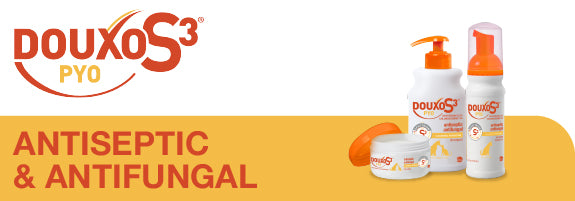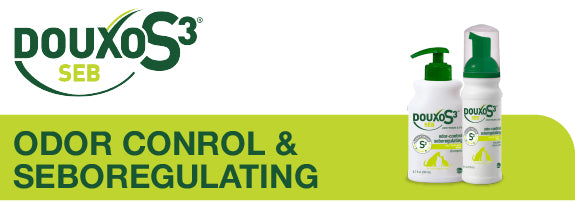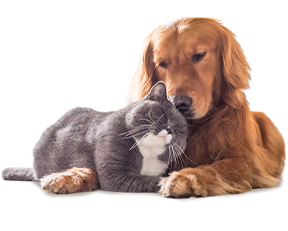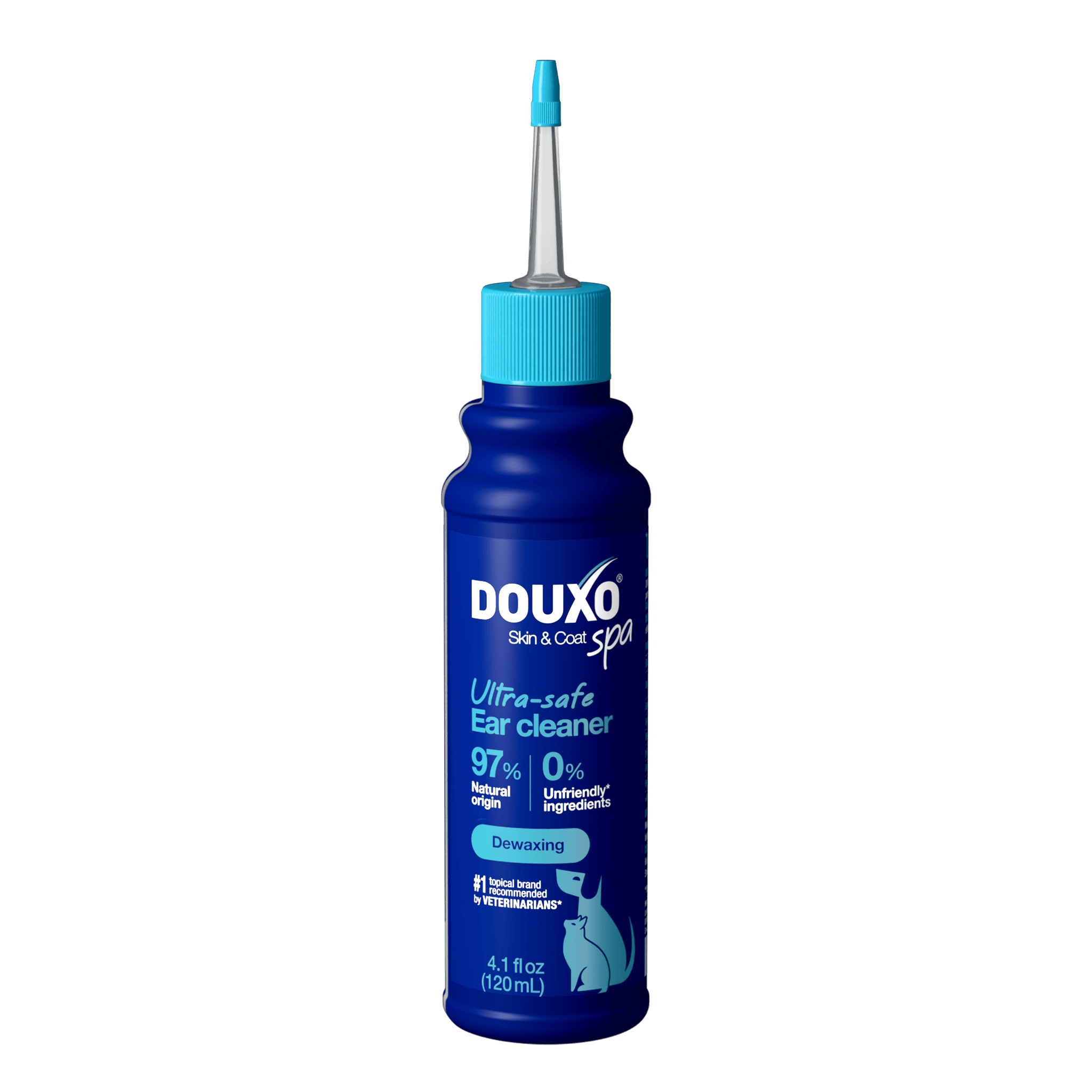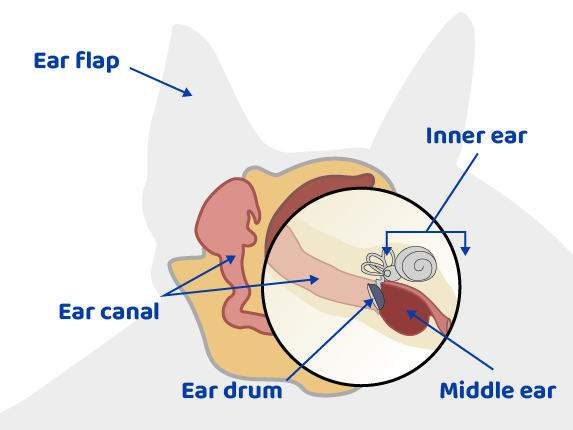3 key points on ear cleaning
How often
How to clean
What to use
Dogs with long ears are prone to otitis and may require more frequent ear cleaning. Getting your dog used to its ears being touched can be helpful in case they need ear treatment in the future.
Recommended product
What you should know about dogs’ ears
Even more so than cat breeds, dog breeds can be very different from one another. That includes how much the shape of their ears can vary. Some dogs have straight ears, while others have floppy ears. In the case of Pugs, some dogs even have “button ears”.
As different as dogs’ ears can look on the outside, the ear anatomy is very similar on the inside. Getting to know the anatomy of the ear helps make it clear why some dogs are prone to ear infections, what signs suggest a problem, and what we can and can’t do when cleaning our furry friends’ ears.
Basic ear anatomy
There are 5 parts of the ear that you should be familiar with:
The pinna – the pinna is the ear flap, which can have different shapes depending on the breed.
The ear canal – the ear canal is shaped like the letter L, which means it has a vertical part and a horizontal part. The pinna and part of the ear canal are visible to us and are also referred to as the outer ear.
The eardrum – also known as the tympanic membrane, the eardrum has a delicate structure that separates the ear canal from the middle ear.
The middle ear – the middle ear is where important structures related to hearing are located.
The inner ear – the inner ear comprises the cochlea, the organ for hearing, and part of the vestibular system, which is responsible for balance.
Combined, these 5 parts play an important role in both balance and a dog’s ability to hear.
What can we learn from understanding the ear structure?
Dogs with long, floppy and drooping ears are prone to develop ear infections, as the ear flap creates a closed, non-ventilated, warm environment that is favorable to the growth of bacteria and yeast. If your dog has an ear problem and starts to tilt their head to the side or show incoordination or a lack of balance, this might mean that the middle and inner ear are affected.
While cleaning dogs’ ears, you should never insert cotton balls into the ear canal, as it can push earwax and other debris further down the ear and damage the eardrum.
When should you clean your dog’s ears?
To clean or not to clean; that is the question!
Cleaning your dog’s ears when required for hygiene reasons can, indeed, help prevent ear problems. Also, getting your pet used to their ears being touched regularly (and from a young age, if possible) will make it a lot easier to treat ear-related issues.
How often should you clean your dog’s ears
Unfortunately, there is not a hard-and-fast rule on how often you should clean your dog’s ears. The truth is, it depends.
If your dog is prone to ear infections, has hairy ears, has been diagnosed with a skin problem or has an endocrine problem such as hypothyroidism, they may need ear cleaning more frequently than other dogs. If this is the case, consult your vet on how often you should clean your pet’s ears. If your dog enjoys swimming, it may be a good idea to clean and dry their ears after to avoid leaving them damp.
As important as cleaning is to keeping your pet’s ears healthy, keep in mind that over-cleaning can result in irritation and overproduction of wax, leading to further ear problems. Some dog breeds are more prone to an excessive production of earwax; for example, some Cocker Spaniels have a genetic condition that causes the issue. Other breeds, such as Basset Hounds, can experience excessive wax buildup due to the length of their ear canals.
When not to clean your dog’s ears
Do not clean your dog’s ears if your dog:
Has red, painful or malodorous ears
Has red, painful or malodorous ears
Has discharge from the ears
Has discharge from the ears
Is scratching their ears or shaking their head often
Is scratching their ears or shaking their head often
Has a head tilt or is showing a lack of balance.
Has a head tilt or is showing a lack of balance.
If you recognize any of these signs, it’s possible your dog has an ear infection and needs to be seen by a vet.
How to clean your dog’s ears
If your dog is used to you touching their ears, ear cleaning is usually a simple and quick procedure. Here are step-by-step instructions for cleaning:
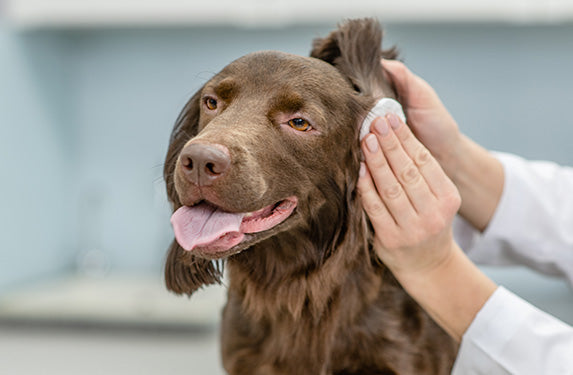
1. Hold up the ear flap gently but firmly to gain access to the ear canal. Before taking the next step, examine the inside of the ear to determine if there is any redness, discharge or strong odor. If you detect any of these issues or if your dog is in pain when you touch their ear, stop and book an appointment to have it looked at by a vet.
2. Insert the spout of the cleansing solution at the entry of the ear canal and squeeze. Your dog will likely try to shake their head. Maintain a firm grip on the ear flap to prevent shaking.
3. Gently massage the base of the ear to help the solution spread through the canal and break up earwax and debris.
4. Now let your dog shake their head.
5. Use a cotton ball to clean the excess product and remove debris from the ear canal and pinna. Remember, you should not use cotton swabs for this.
What products can you use to clean your dog’s ears?
Make sure you choose a veterinarian-recommended cleaning solution to clean your dog’s ears. A dog’s ears are very delicate, and homemade solutions can be irritating and even harmful to your dog. A good cleaning agent should be gentle to not irritate the skin but also effective in removing excess earwax and debris. It’s ideal to look for a solution that has a moisturizing action to help maintain the ear canal’s natural skin barrier as well. A product such as DOUXO® Skin & Coat SPA Dewaxing Ear Cleaner, based on micellar technology, is great for regular care.
Ear hygiene plays a crucial role in preventing earwax buildup and infections. Consult your veterinarian on how often your dog needs its ears cleaned and which products you should use; DOUXO® Skin & Coat SPA Dewaxing Ear Cleaner could be a fit for your furry friend’s needs. With the right solution and treatment plan, you can make ear care quick and easy, keeping your canine companion happy and healthy.


